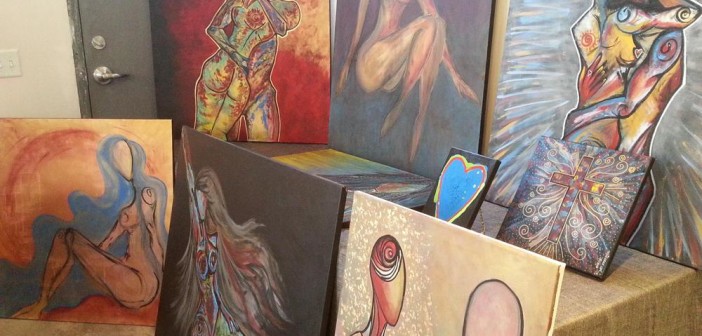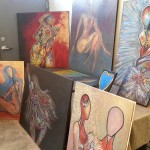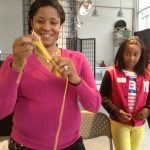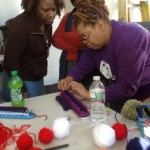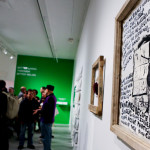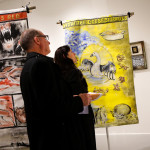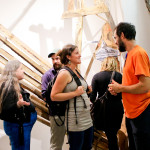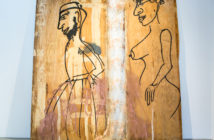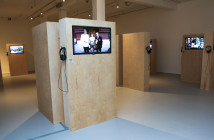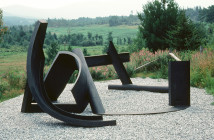Throughout my conversations surrounding this series, the need for infrastructure has emerged as a dominant theme in considerations of art’s role in the innovation hub. In my last post, I discussed the crucial experiments and perspectives artists bring to Boston. Clearly, artists have the potential to become cornerstones of ongoing innovation in Boston, but what about the skills, tools, and resources necessary for the realization of this potential? What layers of infrastructure are needed to support creative processes and ongoing artistic innovation throughout the city?
Several artist-centric nonprofits are already grappling with these questions. The South End’s Boston Center for the Arts, which began operations in 1970 in the midst of civic revitalization efforts, has long worked to support artists and creative practices. BCA Associate Director of Visual Arts Randi Hopkins locates the BCA’s mission within the context of innovation. In conversation, Hopkins commented on the need to involve artists at the core of innovation, given their capacity to engage in the "daydreaming and experimenting" that are essential to knowledge production. Hopkins described the BCA as an incubator, nurturing artists, curators, and others at various points in their careers and helping the Boston community see "who our artists are." The BCA thus provides a space for experimentation and an environment in which artists can exchange ideas with each other and with a broad range of Boston residents through interactive programming, events, and spontaneous conversations.
While the BCA has a long history of working to address the issue of space for artists — which is seen by many as the primary challenge for Boston-based artists — through its studio spaces and nonprofit gallery space, in recent years it has engaged in a broader consideration of its role as incubator. President & CEO Veronique Le Melle notes that when she arrived five years ago, she was struck by the lack of infrastructure for artists, particularly those working in dance and visual arts. She views the BCA’s role as "a fully process-driven organization" within this context. Following its 2011 charrette process, the BCA has sought to use its buildings as tools for supporting creative processes, aiming to upgrade spaces to make them more relevant to the needs of artists, from visual artists working with technology to performing artists, and more widely accessible. The BCA has also provided space for and helped incubate ARTMORPHEUS Advisory Services, which provides professional development services to those in the creative sector. Le Melle emphasizes the need for continuing expansion of professional development infrastructure for artists, pointing to the resources that exist for the technology sector and noting, "If we’re going to have a healthy arts ecology and consider ourselves an innovative city, we need to consider the artist workforce."
 From the I AM KREYOL Art BaZaaR show at the Erick Jean Center for the Arts, Dorchester Arts Collaborative. Courtesy of DAC.
From the I AM KREYOL Art BaZaaR show at the Erick Jean Center for the Arts, Dorchester Arts Collaborative. Courtesy of DAC.Beyond dedicated incubator spaces like the BCA, neighborhood organizations play a key role in both providing infrastructure for artists and integrating artistic practices into the constitution of the city as a whole. While much dialogue on the arts and the innovation hub centers on a handful of neighborhoods, artists work throughout Boston and enrich their communities in important ways. Junior Gustavo, president of the Dorchester Arts Collaborative, pointed out in conversation that if the city truly wants to involve artists in the "innovation hub," neighborhood organizations can serve this goal by continuing to identify, incubate, and expose talent that may otherwise remain largely untapped because of lack of résumé or connections. Given the focus on cultivating new talent that is so central to the language of the innovation hub, investments in incubation at a local level make sense as a method of leveraging residents’ diverse perspectives and abilities, thus maximizing the region’s human resources and its capacity for creation.
Gustavo commented on neighborhood organizations’ deep experience in their localities and the success of DAC programs like Open Studios in sparking conversations among residents of diverse backgrounds, enlivening the Dorchester community, and slowly changing perceptions of a frequently overlooked area of Boston. He noted the centuries-old links between science, technology, and the arts, as well as the explorations these connections encourage. Furthermore, he stressed the foolishness of limiting one’s view of the arts to certain groups or geographic areas rather than taking a more holistic view. "In regards to the Boston community as a whole, I see all community art organizations as an extended branch on a tree," Gustavo said. "We need the support of the trunk to help beautify and diversify that. Trees without branches and leaves aren’t too pretty to look at. It must be a symbiotic relationship built on support."
This emphasis on a holistic view of the arts sector emerged repeatedly throughout my conversations with artists and arts administrators. While popular conceptions of "supporting the arts" may often cluster around large museums, youth programs, and other highly visible forms of arts activity, an enormous diversity of organizations compose the nonprofit arts sector. With strong support, this diversity can allow for a dynamic, thriving, and truly innovative arts ecology that enriches the city as a whole.
In our discussion, Hopkins commented that she has increasingly been thinking about how best to utilize collaboration between nonprofits, from neighborhood organizations to large museums, adding that art’s tradition of exchange and dialogue has particular resonance when pursuing collaboration within the innovation hub’s framework. Le Melle mentioned the BCA’s annual Arts Professionals’ Breakfast and stressed the need for more of this networking and discussion across organizations of all sizes, adding that as a sector, "we need all to make it work."
Notably, the nonprofit professionals I spoke with echoed the optimism that has permeated many of my discussions throughout the series. Viewing the language of the innovation hub and the increased focus on creativity as an opportunity for collaboration and development, they praised recent progress in the cohesion and collaboration of the arts sector. Gustavo remarked that he had seen increasing "solidarity among artists, organizations and supporters of the arts," motivated largely by urgency. He praised MASSCreative’s advocacy efforts, in particular, asserting that "the city can no longer afford to not listen to us."
 About, With & For, curated by Juliana Driever at the Boston Center for the Arts. Photo Credit: Melissa Blackall.
About, With & For, curated by Juliana Driever at the Boston Center for the Arts. Photo Credit: Melissa Blackall.This statement seems prescient in the context of the city’s increasing reliance on the idea of creativity in its branding and approach to success. While vague terms like "innovation" and "creativity" raise significant questions of intent and meaning, the current openness of these ideas presents a pivotal moment for arts organizations. If nonprofits can link with each other and with other allies in fostering artistic processes in Boston, they may be able to leverage the current focus on creativity to build an infrastructure for artists that comes to be seen as a key component of the city. Nonprofits such as the BCA and DAC, which foster local creative practices in their work to provide both physical spaces and professional support systems for artists, express goals for further development that largely parallel the successes of incubators and networking groups in the technology sector. If nonprofits can build upon this foundation and advance the conversation on art’s necessary role in the innovation hub, they have the potential to construct a sustainable infrastructure that will strengthen Boston’s art sector in the long term, regardless of the civic branding du jour.
- From the I AM KREYOL Art BaZaaR show at the Erick Jean Center for the Arts, Dorchester Arts Collaborative. Courtesy of DAC.
- Saturday Mother & Daughter Craft Class at the Erick Jean Center for the Arts, Dorchester Arts Collaborative. Courtesy of DAC.
- Saturday Mother & Daughter Craft Class at the Erick Jean Center for the Arts, Dorchester Arts Collaborative. Courtesy of the DAC.
- About, With & For, curated by Juliana Driever at the Boston Center for the Arts. Photo Credit: Melissa Blackall.
- About, With & For, curated by Juliana Driever at the Boston Center for the Arts. Photo Credit: Melissa Blackall.
- About, With & For, curated by Juliana Driever at the Boston Center for the Arts. Photo Credit: Melissa Blackall.

